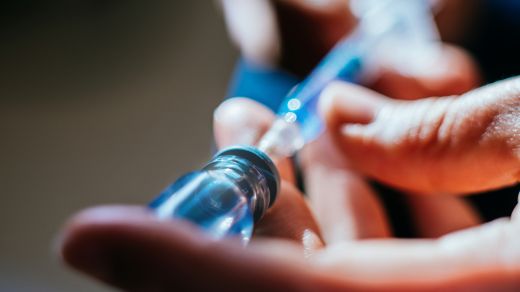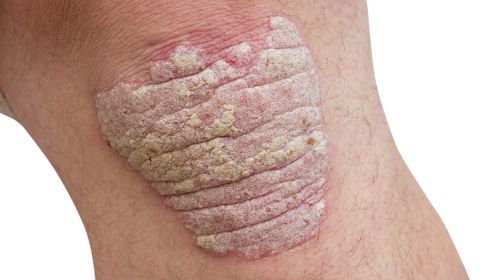Biologics (also biologics or biologics) are genetically engineered drugs that are similar to the body’s own substances and specifically influence various regulatory mechanisms of the body. Read here how and which biologics can help with psoriasis.
- © Getty Images/Guido Mieth
Quick overview: Frequently asked questions and answers
What is a biologic? Biologics are drugs that are made from living organisms and specifically intervene in physical processes to treat diseases or relieve symptoms.
For which diseases are biologics used? They are used primarily for autoimmune diseases and chronic inflammatory diseases such as psoriasis, multiple sclerosis, rheumatism, Crohn’s disease and ulcerative colitis, as well as cancer.
What happens when biologics are used in the body? The active ingredients specifically influence specific components of the immune system to reduce inflammatory reactions or inhibit the growth of cancer cells.
Article contents at a glance:
What are biologics?
Biologics are modern drugs that consist of large protein molecules. They will be obtained from living organisms through biotechnological manufacturing processes (biopharmaceuticals). These include human and animal cells, microorganisms and yeast.
The drugs aim to modify physical processes at the molecular level in order to treat or prevent diseases. In the body, they influence certain functions such as blood clotting or the immune system – they are directed against inflammatory messengers, receptors and immune substances.
In medicine they are also referred to as biological drugs, biotechnologically produced drugs or simply as biologics.
Good to know: Biosimilars are imitation products of biologics that are developed after the original drug’s patent has expired. They are very similar to biologics in structure, effectiveness and safety, but not identical. Biosimilars offer a cheaper alternative to the often expensive biologics.
Bioidenticals, on the other hand, are identical copies of biologics that are manufactured in the same production facility. This means that the substances are generally interchangeable.
Areas of application of biologics
The drugs have a wide range of applications, which is why around 300 biologics have received approval in Germany to date. Antibodies, vaccines, hormones such as insulin or coagulation factors also belong to the group of biologicals.
In addition to psoriasis, they are also used in these cases:
- Rheumatoid arthritis
- Cancer therapy
- chronic inflammatory bowel disease
- Diabetes mellitus
Approved biologics for psoriasis
In principle, biologics can be used in therapy for patients with moderate to severe psoriasis. They are suitable for long-term treatment as part of basic therapy. The following biologics can be used to treat psoriasis:
- Adalimumab
- Etanercept
- Certolizumab
- Infliximab
- Ixekizumab
- Secukinumab
- Ustekinumab
- Golimumab
According to the guidelines, the active ingredients adalimumab (for children over the age of four) as well as etanercept, ustekinumab, ixekizumab and secukinumab (for children over the age of six) can be used to treat children with psoriasis.
How are biologics administered?
Since proteins are destroyed in the gastrointestinal tract, biologics cannot be administered in tablet form. The molecules are therefore given by infusion directly into the blood or as an injection under the skin (subcutaneous injection) into the subcutaneous tissue. Biologicals can be completely absorbed there without being destroyed.
The subcutaneous injection can be carried out independently by those affected. Infusions, however, are administered in the practice under the supervision of a doctor.
How do biologics work?
The idea behind the development of biologics can be illustrated using the example of the so-called TNF-alpha blockers, which are a subgroup of biologics: the body’s own tumor messenger substances are at the heart of the inflammatory immune response in diseases such as psoriasis. Necrosis factor alpha (TNF-alpha) and interleukin 1 (IL-1).
TNF-alpha is produced primarily by phagocytes (macrophages) of the defense system. These macrophages are part of the innate immune system, which plays an important role in a wide variety of defense processes.
The effects of TNF-alpha include, for example:
Activation of arachidonic acid metabolism
Activation of other cells of the defense system (e.g. T and B lymphocytes)
Attracting immune cells to the diseased skin area or joint
Production of oxygen radicals in phagocytes
Promote the production of cartilage and bone degrading enzymes
Inhibition of the joint’s own repair mechanisms by reducing collagen production from the cartilage cells
Increase in feeding processes by granulocytes (a type of white blood cell) and macrophages
The body’s own messenger substances are subject to a complex system of mutual regulation and control. TNF-alpha also has several antagonists in the human body, for example the so-called TNF-binding protein. This complicated balance has become imbalanced in psoriasis. If excess TNF-alpha is captured using recreated binding sites (receptors) or antibodies, inflammatory processes can be effectively slowed down.
Side effects of biologicals
Biologicals suppress the immune system, which means that the susceptibility to infections such as bronchitis and urinary tract infections increases. Severe infections of the lungs or heart muscle are also more common (one in 100). According to studies, overall, five out of 100 people experience side effects.
Reactions at the injection site also often occur: redness, itching, swelling and bruising are initially possible after the injection of biologics, but often improve over the course of treatment. Some studies have shown that side effects caused by biologics are lower than those caused by other systemic drug therapies for psoriasis.


